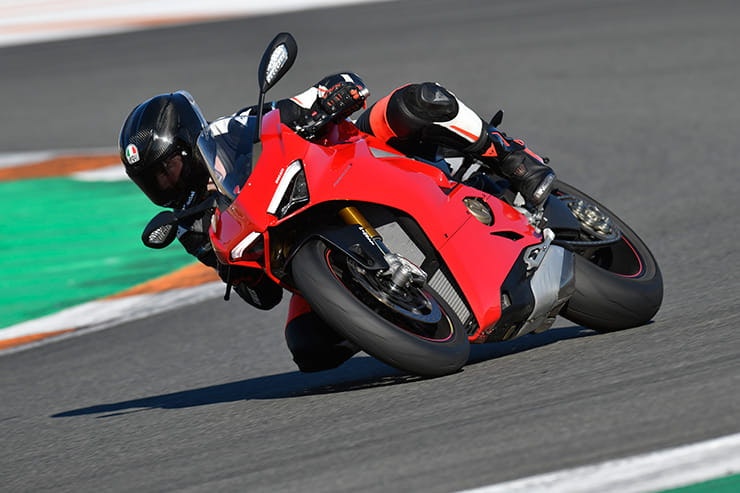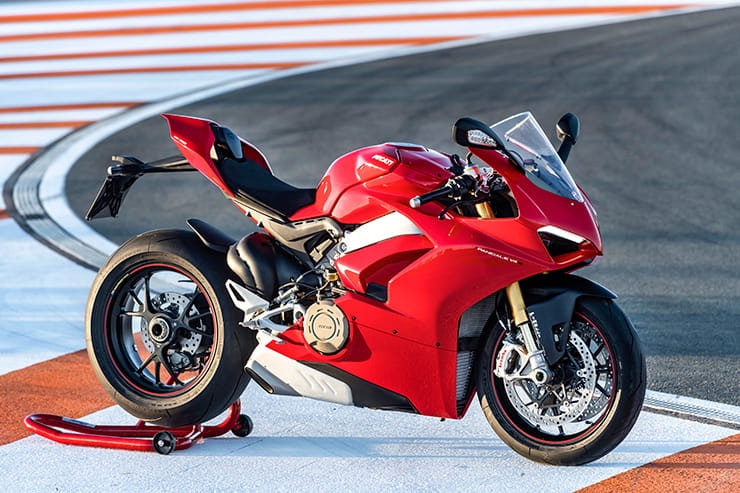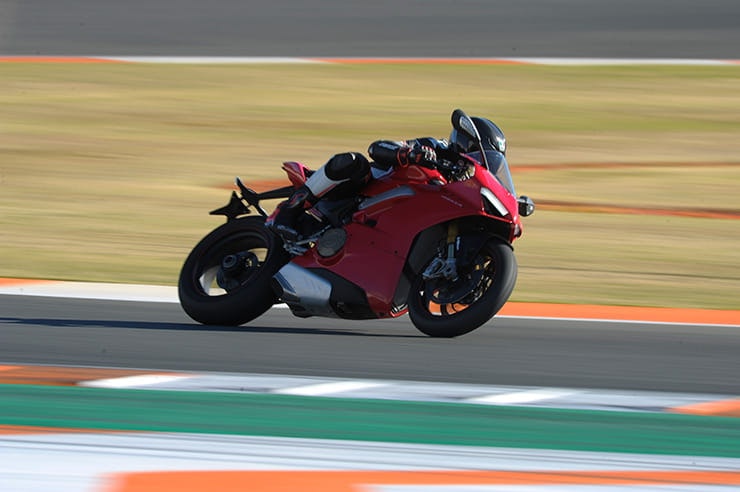Ducati Panigale V4 S (2018) | Review
By Michael Mann
BikeSocial Managing Editor. Content man - reviewer, road tester, video presenter, interviewer, commissioner, organiser. First ride was a 1979 Honda ST70 in the back garden aged 6. Not too shabby on track, loves a sportsbike, worries about helmet hair, occasionally plays golf and squash but enjoys being a father to a 7-year old the most.
23.01.2018
KIT CREDITS - MICHAEL MANN
BOOTS
Dainese Torque D1 Out - £290
GLOVES
Dainese Druid D1 Long - £170
HELMET
AGV Pista GP - £900 for the new GP-R
As good as the hype?
Here marks a brand-new chapter in Ducati’s history. Mark the date, for the Panigale V4 S is about to steal your focus and attention. All £23,895 of glorious, red, Italian sports machinery. Don’t be immediately put off by the price, after all a PCP deal of £255 per month (37 months at 7.1% APR with a £5872 deposit) will see one of these MotoGP-derived road-going motorcycles in your garage. And, how much is that McLaren Senna by the way…£750,000? It certainly makes the Ducati look a reasonable bet to satisfy those with thrill-seeking ways.
Ducati began their press conference by telling us, “With a new engine, frame and electronics the riding experience will be closer than ever to a race bike.”
VIDEO: introducing the Ducati Panigale V4 S from the international press test
We ride the stupendous new Ducati at the Circuit Ricardo Tormo, Valencia and here's what we thought.
Easy to say but did it live up to expectations? Nope, it completely annihilated them and then took those expectations to a quiet place and battered the beejezus out of them. Boy does this thing shift, stop, handle and grip. Let me start by saying this; the new Ducati Panigale V4 S is one of those bikes that once ridden makes you a better human being.
Its feline-like prowess and agility as demonstrated at the International Press Test held at the Circuit Ricardo Tormo in Valencia really puts the ‘cat’ in Ducati – and a very powerful one at that with 214hp @ 13,000rpm hammering your senses. The feeling of coming through the last corner, picking the bike up and, while using some of the outside kerb, ripping the throttle back to the stop, clicking the quickshifter into third, then fourth, then fifth and feeling the monstrous V4 spinning so fast beneath as the clever electronics keep the traction in check as well as both wheels on the ground as it applies maximum power. Yeah, that feeling is one I’ll keep replaying each time I close my eyes.
Latest generation digital unit with 5" TFT colour display
A lot of the talk since the official announcement of the liquid-cooled 1103cc 90-degree Stradale motor back in September was around the age-old pinpointing of power. It was only a few years back when 200+bhp motorcycles were introduced to the world and here we were all of sudden trying to comprehend 214hp (translating to 211bhp) in a road bike. But while the headline figures might often be price and power, sometimes weight, it’s the ability of the Panigale V4 to feed the power, stop it again and handle the corners in such a refined manner while at the same time making you feel like your eyeballs are going to burst with its ferocity which is the very clever part. Ducati have created a demure lunatic.
VIDEO: two on-board laps of the Valencia MotoGP circuit with commentary
Join Michael Mann as he takes us around the Valencia track with a bit of chat to boot!
The 'S' version is fitted with a top spec Öhlins TTX 36 shock absorber
Not-so-humble beginnings
Back in 1988 Ducati brought us their first V-twin (or L-twin as they preferred to call it) sports bike; the 851. Harnessing a 95bhp, water-cooled 4-stroke, 4-valve desmo engine, the bike was introduced initially as a racing prototype and was an instant success winning the second ever WSBK race in ‘88 and then the title in 1990. It’s successes were put down being grippier in the corners with the ability to punch out of them faster than its more powerful rivals.
A V4 race bike didn’t appear until 2003 when the Desmosedici four-stroke bike MotoGP initially under the guidance of Lois Capirossi and Troy Bayliss who went on to finish fourth and sixth in its debut season. Ducati have raced the V4 configuration since, yet here we are having waited 15 years for a V4-based production road bike from Ducati. You could say; it’s been worth the wait.
The new Stradale engine has been inspired by the Desmocedici MotoGP engine, “the V4 configuration was the most ideal for what we were searching for”, said Ducati CEO, Claudio Domenicalli.
Specially developed Pirelli Diablo Supercorsa SP tyres keep the 211bhp in check
It’s been rotated backwards by 42 degrees (like MotoGP) and has the same 81mm piston bore too, the maximum permitted by MotoGP regulations. It didn’t need to be amended, after all its peak power is made at a whopping 13,000rpm. The engine is still a stress member of the chassis and doesn’t require a balancing shaft which is beneficial for weight saving, after all with two extra cylinders over the 1299, the Panigale V4’s motor weighs just 2.2kg more, at 64.9kg. To put that into context, the brand-new cast aluminium front frame (based on GP technology), sub-frame and single-sided swingarm weigh a total of 11.2kg. The magic, also derived from its MotoGP genes (specifically the GP15), and seen for the first time on a Ducati road bike is a crankshaft which rotates in the opposite direction to the wheels, reducing the gyroscopic effect leading to less wheelies, faster turning and a quicker change of direction.
The new bike has a more racing focused weight distribution than the 1299 Panigale S and 1098 S and has 10mm higher foot pegs than the 1299 for extra ground clearance for optimum lean angles – which says something about how the technology has developed to keep the bike and rider the right way up.
A more race focussed weight distribution than previous bikes allows MotoGP levels of lean
And that includes a new generation of Electronically adjustable Ohlins NIX30 43 mm fully adjustable forks and TTX36 shock unit accompanying the Smart EC 2.0 which continuously analysed the bikes behaviour for optimal performance, from grip, weight transfer, brake support, turn-in geometry. While the Bosch Cornering ABS EVO system is split into three modes to ably accessorise each riding mode - front only, slide by brake, road/low grip.
That tech is in turn supported by a pair of superb new boots from Pirelli. Their Diablo Supercorsa SP tyres (rear: 200/60 ZR17. Front: 120/70 ZR17) have been created especially for the Panigale V4 and have a new compound, tread design and slick shoulders offering a better contact area, aided by a 16mm wider diameter at the rear and 1mm wider on the front.
Taming the beast
Trundling down pit lane for the first time and the four sounds similar to a twin, burbling away thanks to the characteristics of its firing order. The first session I spent in the ‘Sport’ riding mode, one of three and in between Street and Race, while I got used to the bike and circuit. All the settings can be manually over-ridden using the two menu function buttons on the left handlebar via the new 5” hi-res TFT dash but with the traction light warning me that some mph’s were being soaked up, I soon switched to ‘Race’ which keeps wheels on the ground while somehow applying all of the bikes vast array of clout.
The power of the V4 is extraordinary - the speed at which it generates the forces to propel both it and you along is astonishing and thank goodness the upgraded Brembo-assisted brakes are equally as powerful and ably assist the accompanying engine braking, demonstrating a willingness to slow just as excited as it is to launch out of each corner. If you play cricket, golf or even football the exciting bit is smashing the balls as hard as possible hoping it goes in the right direction. A tap for a single run, a putt or a backwards pass don’t give you the same thrill. Thankfully Ducati has found a way to offer the permanent feel-good moments throughout any ride with a stunning concoction of metal, aluminium, plastic and electronics. Who knew motorcycle riding could be this rewarding.
The accuracy of the bike’s turning capability made me grin, or possibly gurn, inanely at every corner during the first track session. It has a knack of being able to hit a spot on an apex the size of a kitten’s lip, is easy to manage and is fast without having to fight with it. During every track day I’ve ever done, I’ve always come away thinking ‘I could’ve taken so-and-so corner much better’. The same goes for every section of the Circuit Ricardo Tormo on this day and because the bike had everything under control, I wasn’t sure where the limits were, nor did I fancy finding them. With the security blanket of its advanced Öhlins Smart EC 2.0 suspension and steering damper, Cornering ABS, Slide Control, Traction Control, Wheelie Control and other magical wizardry, my bravery was boosted with every extra angle of lean or twist of accelerator.
It offers a sensation like no other road bike. Ferociously quick with 214hp at your beck-and-call yet smooth in its application. The huge rev range makes a big difference compared to the twin though it sounds very similar. Stood in pit lane listening to the throng of V4s thunder past at full chat and you’d be forgiven in thinking it was a World Superbike.
The inertia from the twin cylinder version from the barky jolt in acceleration and then again in engine braking is nullified with the four-cylinder version.
The way it spins-up pummelling through the revs from 7500 to 13,500 in what feels like the blink of an eye genuinely takes your breath away – a 15-minute track session proves how unfit I am. But let’s come back down to earth for second - is this hyperbike usable on the road? In a world that seems to get stupidly more health & safety conscious and liability-laden, here we have a piece of extraordinary engineering capable of doing extraordinary speeds with extraordinary grip. It has a power to weight ratio of 1.10 hp/kg, compared to the 1299 Panigale S of 1.03, for goodness sakes, so those inevitable car vs bike videos are going to make interesting viewing. It’s a testament to the ambition of Ducati’s engineers and their partners in Bosch, Pirelli and Ohlins because the evolution in the way the electronics look after you, making the Panigale V4 an easier bike to ride fast. Simple to say and even easier to realise the extremity of its potential ability on track but here is a machine whose power is delivered and then taken away in a comforting, reassuring and stable manner that can be transferred to road riding. Sure, like all sports bikes the riding position accentuates weight onto wrists but you don’t buy a 214hp motorcycle to ride to Tesco. Although if you did then you’d be the envy of all the shoppers.
The overall package has taken some of the very best engineering and technological developments from the red bikes of MotoGP gods Andrea Dovizioso and Jorge Lorenzo and their WSB counterparts in Chad Davies and Marco Melandri and applied them into a road bike. Yeah, a bike for the road, with Desmo service intervals of 15,000 miles. Barely believable but also the stuff of dreams for track day heroes.
Panigale V4 S makes 1.10hp/kg compared to the 1299 Panigale S' 1.03hp/kg
Adding some bling
Just when I thought it couldn’t get any better, I was invited to ride an even more special bike; the Ducati Panigale V4 accessorised version. Replacing the treaded tyres for SC1 slick Pirelli’s and the stock exhaust for a full titanium racing Akrapovic system (an extra £3.7k + VAT and fitting) including a remapping of the wheelie control and traction control algorithms removed 7kg yet added an extra 12hp up to 226hp.
Oh my. The pre-warmed extra sticky rubber took the already excelling grip to a new level while the extra power to weight ratio (now 1.20 hp/kg) was a sensation that my brain could scarcely comprehend. There comes a point where my ability becomes null-and-void, it’s all about hanging on. Literally. Physically. It begs the question, how extreme will motorcycle engineering become?
Domenicalli added, “This new engine and bike is really taking the company to a new dimension”. He’s not wrong. I feel like a better human being.
Ducati Panigale V4 Variants Explained
The main features on the standard Ducati Panigale V4 are:
fully adjustable 43mm Showa Big Piston Forks
fully adjustable Sachs monoshock
Sachs steering damper
Electronics package with six-axis Inertial Measurement Unit (which measures roll, yaw and pitch angles) includes:
ABS Cornering Bosch EVO – three levels
Ducati Traction Control EVO includes the new ‘spin on demand’ feature
Ducati Slide Control – with two settings
Ducati Wheelie Control EVO
Ducati Power Launch – three levels
Ducati Quick Shift up/down EVO
Engine Brake Control EVO
Ducati Electronic Suspension EVO
The two direct-access buttons on the left-hand switchgear can be set to adjust either traction control, wheelie control, slide control or engine braking
3 x riding modes (Race, Sport and Street)
16 litre aluminium tank
5” full –TFT dashboard
Full LED headlight
Two seater configuration kit
Braking system with new Brembo Stylema monobloc calipers
Pirelli Supercorsa SP tyres (200/60 at the rear)
Pre-setting for Ducati Data Analyser + GPS and Ducati Multimedia System
While on the V4 S the same features apply except:
Suspension and steering damper with Öhlins Smart EC 2.0 system
Öhlins NIX-30 forks
Öhlins TTX 36 shock absorber
Öhlins steering damper
Aluminium forged wheels
Lithium-ion battery
Cast Magnesium alloy front sub frame
And on the V4 Speciale the same features as the V4 S except:
Carbon fibre front/rear mudguards
Machined-from-solid top yoke with identification number
Alcantara seat
Dedicated handle grips
Adjustable foot pegs
Carbon fibre heel guard
Carbon fibre swinging arm cover
Racing articulated levers
Racing fuel tank cap
Brake level protection
Supplied kit:
Full racing titanium Ducati Performance by Akrapovič exhaust system
Racing screen
Plate holder removal kit
Machined-from solid mirror replacement plugs
Ducati Data Analyser+ GPS (DDA + GPS)
Bike cover
Ducati Panigale V4 Technical Specifications


